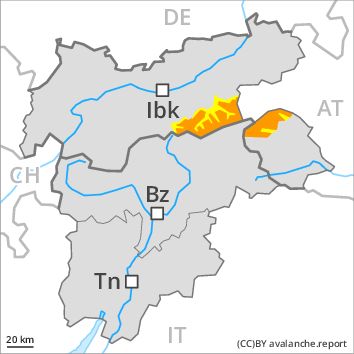Regions
Weißkugel Range, Western Verwall Mountains, Gurgler Range, Central Stubai Alps, Eastern Verwall Mountains, Allgäu Alps, Silvretta, Samnaun Mountains, Eastern Lechtal Alps - Ammergau Alps, Northern Oetz and Stubai Alps, Mieming Mountains, Karwendel Mountains, Western Lechtal Alps, Central Lechtal Alps, Glockturm Range, Grieskogel Mountains

Danger level
Danger Level 3 - Considerable
Avalanche Problem
Persistent weak layer above 2600m above 2000m, N-NE-E-W-NW
Wet snow above 2300m, N-NE-E-SE-S-SW-W-NW

Weakly bonded old snow requires caution. Wet and gliding avalanches are possible.
Weak layers in the old snowpack can be released in some places even by individual winter sport participants in particular on steep west, north and east facing slopes. At transitions from a shallow to a deep snowpack, when entering gullies and bowls for example the snowpack is more prone to triggering. The fresh wind slabs can in some cases be released by small loads.
The avalanche prone locations are barely recognisable because of the poor visibility. Whumpfing sounds and the formation of shooting cracks when stepping on the snowpack serve as an alarm indicating the danger. Ski touring and other off-piste activities, including snowshoe hiking, call for experience in the assessment of avalanche danger. The avalanche situation is more favourable in highly frequented off-piste terrain.
As a consequence of the rain, the likelihood of natural avalanches being released will increase below approximately 2300 m.
Snowpack
dp 7: snow-poor zones in snow-rich surrounding
dp 3: rain
Faceted weak layers exist in the snowpack in particular on steep west, north and east facing slopes, in particular in places that are protected from the wind between approximately 2200 and 2600 m. Relatively hard layers of snow are lying on old snow containing large grains.
In some regions rain to 2300 m.
Tendency
Slight increase in avalanche danger as a consequence of fresh snow and strong wind.
Regions
Northern Zillertal Alps, Venediger Range

Danger level
Danger Level 3 - Considerable above 2000m
Danger Level 2 - Moderate above 2000m
Avalanche Problem
Persistent weak layer above 2600m above 2000m, N-NE-E-W-NW
Wind-drifted snow above 2400m, N-NE-E-NW

Wind slabs and weakly bonded old snow represent the main danger.
Weak layers in the old snowpack can be released in some places even by individual winter sport participants in particular on steep west, north and east facing slopes. At transitions from a shallow to a deep snowpack, when entering gullies and bowls for example the snowpack is more prone to triggering. The fresh wind slabs can in some places be released, even by a single winter sport participant.
The avalanche prone locations are barely recognisable because of the poor visibility. Whumpfing sounds and the formation of shooting cracks when stepping on the snowpack serve as an alarm indicating the danger.
Ski touring and other off-piste activities, including snowshoe hiking, call for experience in the assessment of avalanche danger. The avalanche situation is more favourable in highly frequented off-piste terrain.
Snowpack
dp 7: snow-poor zones in snow-rich surrounding
dp 6: cold, loose snow and wind
Faceted weak layers exist in the snowpack in particular on steep west, north and east facing slopes, in particular in places that are protected from the wind between approximately 2000 and 2600 m. Relatively hard layers of snow are lying on old snow containing large grains.
As a consequence of a storm force wind from westerly directions, sometimes avalanche prone wind slabs will form in particular at high altitudes and in high Alpine regions, especially on wind-protected shady slopes.
Tendency
Slight increase in danger of wet and gliding avalanches as a consequence of the rain.
Regions
Western Tuxer Alps, Eastern Tuxer Alps, Brandenberg Alps, Western Kitzbühel Alps, Wilder Kaiser Mountains - Waidring Alps, Eastern Kitzbühel Alps

Danger level
Danger Level 2 - Moderate
Avalanche Problem
Wet snow above 2300m, N-NE-E-SE-S-SW-W-NW
Wind-drifted snow above 2300m, N-NE-E-NW

Wet and gliding snow represent the main danger. Wind slabs require caution.
Increase in danger of wet and gliding avalanches as a consequence of the rain. Natural avalanches are possible.
The fresh wind slabs can in isolated cases be released by a single winter sport participant. The avalanche prone locations are barely recognisable because of the poor visibility.
Snowpack
dp 3: rain
dp 6: cold, loose snow and wind
In some regions rain to 2300 m. As a consequence of a storm force wind from westerly directions, sometimes avalanche prone wind slabs will form in particular at high altitudes and in high Alpine regions, especially on wind-protected shady slopes.
Tendency
Slight increase in danger of wet and gliding avalanches as a consequence of the rain.
Regions
Sexten Dolomites, Latemar, Western Deferegger Alps, Ulten Valley, Eastern Nonsberger Alps, Eastern Rieserferner Mountains, Northern Dolomites of Fiemme, Glockner Range, Gröden Dolomites, Southern Adamello, Eastern Deferegger Alps, Prags Dolomites, Sarntal Alps, Adamello - Presanella, Schober Mountains, Northern Brenta - Peller, Lienzer Dolomites, Western Nonsberg Alps, Southern Brenta, Fassa Valley, Sole, Pejo and Rabbi, Maddalene

Danger level
Danger Level 2 - Moderate above the treeline
Danger Level 1 - Low above the treeline
Avalanche Problem
Wind-drifted snow above the treeline, N-NE-E-SE-NW
Wet snow above 2600m, SE-S-SW-W

The danger of dry and wet avalanches will increase a little during the day.
The more recent wind slabs can still be released in particular on steep shady slopes above the tree line. As a consequence of warming during the day small and, in isolated cases, medium-sized moist and wet avalanches are possible. They can be released in the weakly bonded old snow in particular in areas where the snow cover is rather shallow. In particular transitions from a shallow to a deep snowpack where weaknesses exist in the old snowpack are precarious.
Snowpack
The strong wind will transport the loosely bonded old snow. In particular above the tree line mostly small wind slabs will form. Large-grained weak layers exist in the snowpack especially on steep, rather lightly snow-covered shady slopes. At high altitudes and in high Alpine regions the avalanche prone locations are more prevalent.
Tendency
The wind will be strong to storm force over a wide area.




